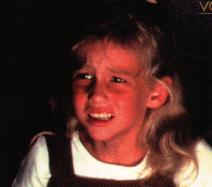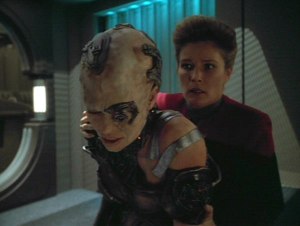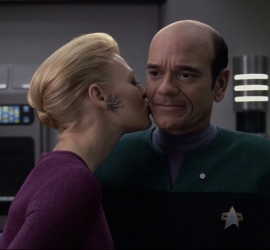 Many of you know I occasionally cosplay as Seven of Nine from the Star Trek series, Voyager. I have always had a fascination with the non-human characters that allow us to see our own humanity reflected back at us through them. Spock is the original example of this construct. Data arguably captured this the best of all, but what has struck me is how polarizing the character Seven of Nine can be for some people. Sure, she’s a fetishist’s dream with her skin-tight catsuit, her flawless up-do and curvaceous figure. Her look was clearly drawn up by a bunch of men who have seen one too many Hitchcock films. However, I find it fascinating that a character so “sexed-up” on the outside is actually rather asexual on the inside. That’s what makes her complex. She has no concept of how powerful her sexuality is. She was raised by wolves, stripped of a normal childhood and thrown onto a starship with total strangers. She is a complex character with a conflicted identity suffering from Post Traumatic Stress Disorder. This disorder is defined as a ” severe condition that may develop after a person is exposed to one or more traumatic events, such as sexual assault, serious injury or the threat of death.” Before we get into what makes her such a deeply troubled character, let’s first define what the Borg do.
Many of you know I occasionally cosplay as Seven of Nine from the Star Trek series, Voyager. I have always had a fascination with the non-human characters that allow us to see our own humanity reflected back at us through them. Spock is the original example of this construct. Data arguably captured this the best of all, but what has struck me is how polarizing the character Seven of Nine can be for some people. Sure, she’s a fetishist’s dream with her skin-tight catsuit, her flawless up-do and curvaceous figure. Her look was clearly drawn up by a bunch of men who have seen one too many Hitchcock films. However, I find it fascinating that a character so “sexed-up” on the outside is actually rather asexual on the inside. That’s what makes her complex. She has no concept of how powerful her sexuality is. She was raised by wolves, stripped of a normal childhood and thrown onto a starship with total strangers. She is a complex character with a conflicted identity suffering from Post Traumatic Stress Disorder. This disorder is defined as a ” severe condition that may develop after a person is exposed to one or more traumatic events, such as sexual assault, serious injury or the threat of death.” Before we get into what makes her such a deeply troubled character, let’s first define what the Borg do.
The Borg operate to “add the biological and technological distinctiveness of other species to [their] own… [in pursuit of] perfection”. It’s an unemotional, mechanical perfection that the Borg are motivated to achieve. They obtain this perfection through a forced assimilation where they steal the technology and traits of individuals or whole species. One can only imagine how invasive this procedure is. A single injection from a tubule can carry five million nanobots, rapidly affecting the bloodstream, starving the individual of oxygen and causing irreparable brain damage. While the process has many more steps, it’s the alarming rate in which all this takes place that may be the scariest notion of all. The Borg are efficient to say the least. The Borg do not negotiate, they do not have compassion or weakness. They just take. After all, their famous line is “resistance is futile,” which may get thrown around as a funny Trek phrase, but think about it’s true meaning. They are saying don’t bother fighting back. It’s pointless. We will destroy you at all cost.
Now replace that idea of the Borg in combat with one directed at a human child – a pretty frightening premise indeed. They terrorize a six-year-old child with nanoprobes that will penetrate her body while she is forced to witnesses the assimilation of her parents. Seven is stripped of everything familiar. She is no longer Annika Hansen. She no longer has a loving family structure. It is replaced by a forced technological one where there is no sense of individuality. Like many victims of abuse, she then went on to become the abuser. As a member of The Collective she assimilated countless others. Because of Seven’s young age during assimilation, her emotional growth was stunted.
The first time the audience meets Seven, she is resistant to change. She fights back. While her link to The Collective is severed, she demands to be returned to the Borg and is caught trying to make contact. This is not uncommon of victims of abuse to want to return to their abusers. They are afraid to be independent. Domestic violence is often a co-dependent situation. There’s a strong parallel between Seven rejecting and not understanding her individualism with survivors who reject freedom. She wants to go back to the familiar and resents the Voyager crew for trying to force her to connect with her humanity.
But, what other PTSD symptoms does Seven display? Like many survivors she experiences body aches and pains, irritability and aggression. And throughout her journey on Voyager, Seven experiences hallucinations and flashbacks to her assimilation. In the episode “The Raven,” The Doctor tells her that her flashbacks are likely post traumatic stress disorder. She replies, ” I was not traumatized, I was raised by the Borg. I don’t see them as threatening. Why would I experience fear?” She describes the Borg in sympathetic terms instead of seeing what they took away from her. This is also something many victims of childhood abuse do. There’s an element of denial coupled with a desire to protect the abuser. It’s interesting because in other instances, she displays anger towards her parents for bringing her on such a risky mission in the first place.
The Mayo Clinic says that PTSD can be grouped into three types: intrusive memories, avoidance and numbing, and increased anxiety or emotional arousal (hyper-arousal). With Seven of Nine, we definitely see intrusive memories in for the form of flashbacks. In the episode “One,” Seven hallucinates a variety of scenarios due to her isolation. She hallucinates the Borg taunting her for being weak, reinforcing the notion that she cannot survive without them.
Like many victims of childhood abuse or PTSD, Seven is shy and uncomfortable in social settings. Because her assimilation happened at such a young age, she never developed certain social skills . She has no interest or concept of sexuality, manners and social cues. In the episode “Human Error,” she uses the holodeck as a way to understand intimacy and social interaction. She gets lost in fantasy and cannot tell the difference between it and reality. That is quite common in abuse victims. In the same episode, she reveals to The Doctor that she is having shoulder pain and he notices she has missed regeneration cycles. Survivors often suffer from poor health, social disconnection and sleep disturbances. We can see by her behavior in “Human Error” that Seven is definitely disassociative. She is nervous to attend Torres and Paris’ baby shower so she skips it. Even though Seven tries to appeal to her emotional side, her Borg side still remains. Her cortical node was designed to shut down her higher brain functions when she starts experiencing emotions. In other words, the Borg ensured a fail-safe device to make sure drones maintain efficiency without distraction of emotion. Even though the Doctor offers surgeries as an option, Seven opts not to have them performed and accepts that this will always be a part of who she is.

Seven’s response to The Doctor singing Rock- a- Bye-Baby. “Are you trying to soothe the infant, or traumatize her?”
In a different episode, “Retrospect,” Seven has an anxiety attack while The Doctor is examining her. She incorrectly accuses an alien of an attack, experimentation and memory wipe, confusing this for what she experienced with the Borg. She wants him to suffer and when his ship is destroyed she experiences remorse for the first time.
As the seasons of Voyager go on, you see Seven (through the help of Janeway and The Doctor) rediscover aspects of her humanity. Many of these scenes are awkward, funny, joyful and heartwarming. Seven of Nine is perhaps a great model for young women in that she experienced a life-altering encounter, but was still able to come out on the other end an intelligent, strong and loyal individual. More importantly, she’s able to care for others again, making the crew her new collective.
Say what you will about Voyager, but Seven of Nine cannot be disputed as one of the most layered, fully-developed female characters in science fiction. Once you get past the catsuit, you will see Jeri Ryan was a tremendous performer who was able to tap into some difficult terrain. I hope we continue to see more female characters who are not some ideal of perfection, but rather are deeply flawed. We can relate to flaws. Perfection, I’ll leave to the Borg.


